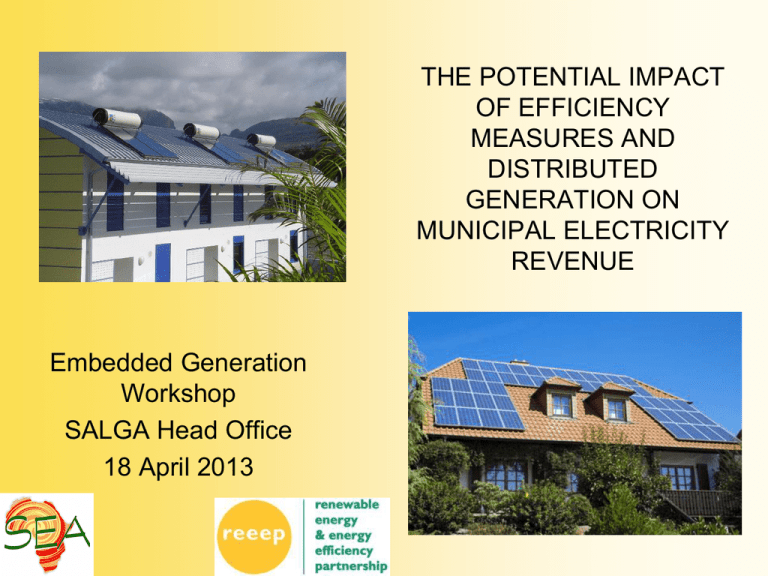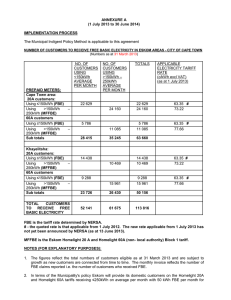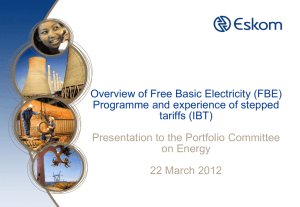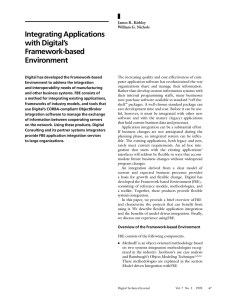SSEG 3_ SEA_Impact of EE and RE interventions
advertisement

THE POTENTIAL IMPACT OF EFFICIENCY MEASURES AND DISTRIBUTED GENERATION ON MUNICIPAL ELECTRICITY REVENUE Embedded Generation Workshop SALGA Head Office 18 April 2013 Issue overview Steep electricity price increases are making technologies like rooftop photo voltaics and solar water heaters financially attractive to high end users Cross subsidising low income electrification • Mounting pressure to electrify informal settlements Household growth projections Showing the potential growth in the informal sector if current trends continue Low income electrified Low income unelectrified (informal) Med income (elec) Hi income (elec) Cross subsidising low income electrification Rmillion Cross subsidisation (Source: PDG) 6,000 5,000 Surplus 4,000 Deficit 3,000 Equitable share 2,000 User charges 1,000 Cost - Revenue Low income Cost Revenue High income Cost Revenue Cost Non-residential Issue overview Municipalities depend on high end users for additional income. What will the impact of them becoming more efficient and installing pv be on local government in the next 10 years? Annual financial surplus/shortfall per service 800 Electricity 600 R millions 400 200 Water - 2010 -200 -400 -600 -800 2011 2012 2013 2014 2015 2016 What happens when 2017 2018 revenue 2019 electricity drops such that city books can’t balance? REEEP Project Objectives • Support 4 Metros – eThekwini, Ekurhuleni, Cape Town and Joburg for next 10 months • Develop accurate financial and energy models from which City business strategies can be designed to address revenue and service delivery threats • Feed info into IRP process REEEP Project Objectives In detail look at impact of: • Informal settlement growth and electrification needs • commercial and residential pv + efficiency interventions • different tariff options and develop a strategy to address these factors effectively Work done to date • Developed version 1 of a tool to accurately calculate potential revenue loss from RE and EE implementation by municipal electricity end users Tool design Necessary to include • varying time of day, weekday/weekend and seasonal bulk purchase tariffs in calculations • realistic data for PV and SWH impact over 24 hr period and over summer and winter • realistic technology uptake data 140 PV output (MW) 120 100 80 MW (summer)* 60 MW (winter)* 40 20 0 1 2 3 4 5 6 7 8 9 10 11 12 13 14 15 16 17 18 19 20 21 22 23 24 Preliminary Outputs: Cape Town Preliminary Outputs: Cape Town Preliminary Outputs: eThekwini Preliminary Outputs: eThekwini Preliminary Outputs: Ekurhuleni Preliminary Outputs: Ekurhuleni Preliminary Outputs: Joburg Preliminary Outputs: Joburg Load profile modelling results Intervention impact • SWH and PV largest impact • Adopted by high end users most affected by price increases • Extra revenue loss impact as a result of users being on inclining block tariff • Revenue losses from this market are potentially serious • Commercial uptake of PV not modelled, but also expected to be significant Findings • Alternative tariff management approaches can address the problem – Fixed charge for net metering – though may not avoid installation for ‘own use’ – Decoupling energy and operational charges. Reintroduce a network service charge – Time of Use tariffs Impact of FBE (CCT) • SWH and PV use could move a large portion of the middle income residential market into FBE bracket (below 450kWh/month). • In today’s electricity rates, a user currently just below 600 kWh/month will move into FBE just from installing a SWH. Impact of FBE • Impact without FBE – 34% drop in income to City per customer • Impact with FBE – 61% drop in income to City per customer Next Steps • Include more detail around current tariffs • Determine impacts of • moving away from large differential inclining block tariff • net metering tariffs for PV • decoupling City revenue from electricity sales ie service charge for City costs and energy charge for Eskom repayment • time of Use tariff • FBE adjustment • low income electrification Thank You Andrew Janisch andrew@sustainable.org.za 021-7023622 0849558130











